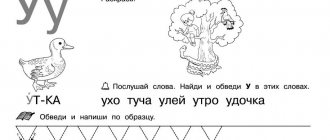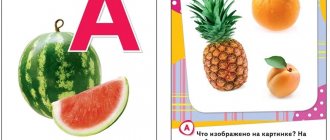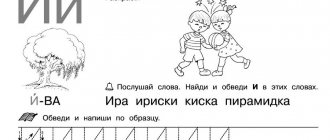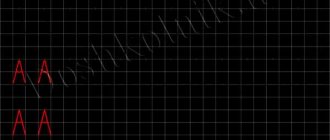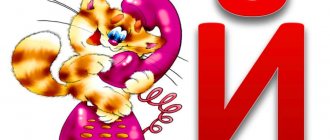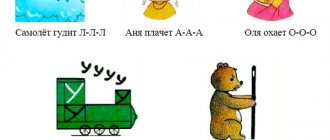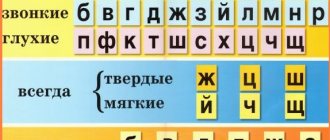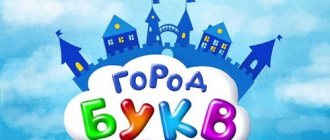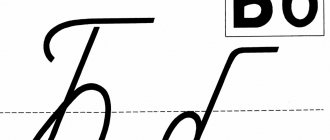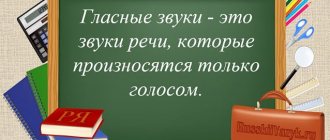Literacy learning construct “The sound [O] and the letter O”
The construct of direct educational activities in preparation for learning to read and write with children in a pre-school group
Topic: “The sound [O] and the letter O”
Age group:
seven year old children
Form of work with children:
communicative
Form of organization:
group
Training and metodology complex:
independent development
Materials and equipment:
Visual range:
Picture of a letter, ball, table for characterizing sounds, “Letters and sounds” album “What do letters look like?”, picture of an island, cards with syllables: AOU, OU, Aou, Uao, Uoa
Literary series:
V. Stepanov “There is a hollow in an old tree”, Y. Tuvim “How are you living? Like this?"
Handout:
envelopes with stripes and red squares, laces according to the number of children, workbooks “Learning to read and write” (part 1), pencils and colored pencils, individual mirrors (according to the number of children)
Preliminary work:
- Learning physical education minutes
| Objectives of the educational program | Tasks taking into account the individual characteristics of students |
Educational:
Educational:
Educational:
|
|
| Stages (sequence) of activities | Contents of the activity | Actions, activities of the teacher | Actions, activities of children, the implementation of which will lead to the achievement of planned results | Planned result |
| Motivation. (Stage 1) Mimic gymnastics | P: Children, imagine that you and I find ourselves on a desert island. At first we were surprised: Oh! Then they got upset: O-o-o! They saw the ship and joyfully exclaimed: Oooh! And now we return to the kindergarten on the ship: Oooh! We were glad that we returned to kindergarten: Aaaaah! | The teacher tells the children, displays a picture of the island and shows facial exercises | Children express different emotional states with facial expressions. | Ability to express emotional state through facial expressions Children's readiness for class |
Sound and letter O
Subject,
Target:
1. Clear sound pronunciation.
2. Emphasizing the sound O (under stress after a consonant).
3. Reproduction of syllable series (to-to, to-to
etc.).
4. An exercise in the formation and use of the genitive plural of nouns - making sentences based on subject pictures with the word a lot according to a given model.
5. Introducing the letter O, typing, exercises with split alphabet.
Equipment: subject pictures (house, cat, horse, moss, lemon, skating rink, windows, window, sink, coat, wreath, carriage, trunk, loaf, can, legs, deuce, poplar, perch, sheet music, horseshoe, room, jacket , binoculars, album, peony, hoopoe, hunter, bandage, cotton wool, shoes),
story picture
“Rink”,
notebooks, pencils, cut-out alphabet books.
Progress of the lesson
I. Organizational moment (complex instructions: recalling pictures in A, U, I). P. Repetition of studied vowels: guessing by articulatory posture, pronunciation, comparison.
III. Introducing the topic based on the results of the game “The Fourth Wheel”:
a) cat, hare, bear, fox, cow, goat, dog, perch, radish , lemon, cucumber, pumpkin sofa, bed, window, chair
b) remembering the names of the selected pictures, reproducing a number of words: cat
-
perch - lemon
-
window;
c) isolating the sound O from a given series of words.
IV. Pronunciation of the sound O, characteristics of the sound, observation of articulation and phonation.
V. Sound production O:
a) from the sound series: o, a, u, i, o, i, a, o, a, u, o, i, uh...;
b) from the syllabic series: at, from, op, un, ok, it, then, pa, ki, ko, ku, po, ut...;
c) from a number of words: fence, cabbage, vegetable, tail, old man, cat, rooster, glass, toad, motor, beetle, taxi, cake, cardboard...;
d) selection of pictures for the panel - the game “Find and correct mistakes.”
VI. Formation of sound analysis skills:
a) highlighting a vowel after a consonant in a direct syllable, transformation - the game “Living Sounds”:
ka -> ko pu -♦ po te -" then ti -" then
b) reproduction of syllable series from straight syllables with the sound O:
by-to by-to by-by by-by by-by
c) highlighting the sound O after a consonant under stress in words based on pictures - game “1-2-3”:
finding pictures starting with O at the beginning of a word, at the end of a word; looking at the remaining pictures.
Conclusion:
the sound O in the middle of a word (after a consonant).
VII. Getting to know the letter O: looking at it, looking for it, tracing the outline, typing.
VIII. Exercises with a split alphabet: compiling, following the analysis, transforming and reading syllables:
ok -+ co op -> by from -♦ then
IX. Typing from dictation of syllables: ok, to, po, op, from, then.
X. Physical education lesson with the tongue twister “From the clatter of hooves...”.
XI. Exercise in the formation and use of the genitive case of nouns (singular and plural), composing sentences using individual pictures with the words many, no, according to the example:
a) selection of names based on the sound O:
Tanya, Dina, Shura, Toma, Tolya, Dima, Vasya, Petya;
b) game “A lot - no”:
Tolya has a lot of lemons. Tom has no lemons (lemon).
XII. Bottom line. Pronunciation, characteristics of the sound O. Examination of the painting “Skating Rink”. Coming up with words with sound
About this picture: Kolya, Tolya, Tom, Tonya, skating rink, water
(if necessary, help from a speech therapist:
Come up with names with the sound O. What are Tolya and Kolya doing? What will happen here? Who will Kolya and Tolya ride?).
Consolidation in subgroup speech therapy sessions
1. Game “Remember, repeat”:
in some way in a way in a way
etc.
2. Game “A lot - no” (remembering the names of pictures in O).
3. Game for sound analysis and synthesis “Live sounds” {from, op, up, ok-, to,
by, then, that).
4. Gymnastics for hands with a tongue twister: “From the clatter of hooves there is dust on
flies across the field."
Work of a teacher on the instructions of a speech therapist
1. Articulation and finger gymnastics.
2. See subgroup lessons 1-4.
3. Consolidation of graphic skills and orientation on a plane.
LESSON 11
Sounds Y-L'
Subject.
Target:
1. Correct pronunciation and distinction of sounds.
2. Consolidation of ideas about the softness of consonants.
3. Exercise in distinguishing masculine, feminine, neuter nouns, correlating the possessive pronouns mine , mine, mine with nouns.
4. Practical mastery of verb conjugation in the present tense (without the 2nd person singular).
5. Prefixed verbs - making sentences based on plot pictures.
6. Formation of relative adjectives from the names of trees: linden, maple, poplar, viburnum , etc.
Equipment: subject pictures (lemon, lion, ribbon, deer, tulips, linden, bread, beak, spruce, album, raspberry, cage, ruler, elevator, snail, clearing, swan, peacock, pelican, waffles, coat, felt boots, wicket , lighthouse, linen, kopeck, skirt, T-shirt, yacht, coffee pot, berries, sink, deuce, quince, parrot, button accordion),
plot pictures based on prefixed verbs from the verb
to pour (water tulips, pour water, pour out),
plot picture
“Children help mom.”
Progress of the lesson
I. Organizational moment (remembering pictures in K, K').
II. Isolating the sound L' from words: ruler, glue, lily, steel.
III. Pronunciation and characteristics of the sound L': consonant, smooth, soft.
IV. Isolation of the sound L' by ear, pronunciation, differentiation L'-Y:
a) la, i, li, al, ai, i, lyu, yul, yu, le, spruce, e...;
b) tree, apple, ice, hedgehog, south, people, hatch, Julia, Lyuba, Lena, ate, spruce, log...;
c) according to the pictures on the panel:
pronunciation, selection of pictures in L', complicated by a grammatical task:
composing phrases with possessive pronouns my, mine, my
(according to this example):
This is my lion.
V. Sound analysis and synthesis of reverse syllables: al, ol, ul, il.
VI. Reproduction of syllable rows:
al-ol-ul-il la-le-lu-li
,
etc. VII. An exercise in using prefixed verbs from the verb to pour:
a) making sentences based on story pictures using questions:
Lena waters the tulips. Kolya waters the tulips. Olya pours water into a watering can. Tolya pours water into a watering can. Luda pours water from a watering can. Lenya pours water from the watering can.
b) converting singular present tense verbs into plural:
Lena and Kolya water the tulips. Olya and Tolya pour water into a watering can. Lyuda and Lenya pour water from the watering can.
c) converting plural verbs of the present tense into the plural of the past tense:
Lena and Kolya watered the tulips. Olya and Tolya poured water into a watering can. Lyuda and Lenya were pouring water from a watering can.
VIII. Conjugation of present tense verbs according to the model (2nd person singular excluded):
Water the lilies.
Sculpt a deer. Pecking cranberries.
IX. Physical education lesson with tongue twisters: We drove and drove, we got to the maple tree, we drove around the maple tree and went home.
(The same with
linden, spruce, poplar).
X. Compiling a story based on the painting “Children Help Mom”:
a) formation of full names:
Tolya
-
Anatoly Lena
-
Elena Ilyusha
-
Ilya
b) selection of names of trees and shrubs with the sound L': poplar, linden, maple, viburnum, raspberry;
c) conversation:
What is Elena doing? Who does Elena help? What are Anatoly and Ilya doing? What will there be a lot of here?
d) combining answers into a story, memorizing:
Children help mom. Elena helps her mother wash the windows. Anatoly and Ilya are digging holes. There will be a lot of maples, lindens, poplars, viburnums, and raspberries.
XI. Formation of relative adjectives from the names of trees and shrubs - the game “Let's arrange alleys in the new garden”:
from maples
-
maple from linden -
linden from poplars
-
poplar from viburnum
-
viburnum
XII. Bottom line. Pronunciation of the sound L', characteristics. Game “Finish the word”: tu., mo., e., ju., ug., me..
